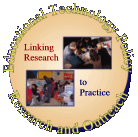Introduction:
To introduce this section read chapter 2 dissertation excerpts from COMMUNITY AND EDUCATIONAL OPPORTUNITY IN THE U.S.: NEW IMMIGRANT AND LOW-INCOME VOICES ABOUT THE RELATIVE UTILITY OF DIGITAL LITERACY (Davina Pruitt-Mentle, 2006).
Since the mid-90's several studies and reports have tried to document and analyze the impact that the information revolution could have on the lives of U.S. citizens. A consensus of report findings indicate: information and communications technology (ICT) or "technologies" has spread faster than any previous communications invention and has begun to affect nearly every aspect of today's U.S. citizens; technologies have begun to change the way opportunity is provided to citizens across the fields of educational achievement, improved health, economic opportunity, and community participation; and there are technology gaps whereby groups are missing out on certain benefits technology can offer, particularly low-income, and ethnic minority populations These gaps document a disturbing inequality in terms of who reaps the benefits of digital opportunity.
A plethora of literature exists on what has been coined by the U.S. National Telecommunications and Information Administration under the Clinton administration as the "Digital Divide". The Digital Divide is a common term used to describe the inequalities that exist with respect to the use of Internet and other telecommunication services; it is shorthand for any and every disparity within an online community. Digital Divide has become the accepted term for referring to the social implications of unequal access for some sectors of the community to ICT, along with an inability to acquire the necessary skill set for use, recently referred to as "digital literacy". However there is a growing recognition that access alone, while necessary, is not sufficient. "The notion of a binary divide between haves and have-nots is thus inaccurate and can even be patronizing because it fails to value the social resources that diverse groups bring to the table" (Warschauer, 2003, p. 7). Kling states,
[The] big problem with "the digital divide" framing is that it tends to connote "digital solutions," i.e., computers and telecommunications, without engaging the important set of complementary resources and complex interventions to support social inclusion, of which informational technology applications may be enabling elements, but are certainly insufficient when simply added to the status quo mix of resources and relationship (quoted in Warschauer, 2003, p. 7).
van Dijk (2003) has argued that physical access and demographics are of limited value, calling for more scholarly work that focuses less on conditions and more on criteria (Bridges & Callister, 2000). New work along with new terminology has started to surface to include: social inclusion (Warschauer, 2002, 2003a); real access (Bridges, 2001); digital inequity (Kvasny, 2002; Di Maggio & Hargittai, 2001); and multifaceted concepts of access (van Dijk, 2003).
The growing consensus regarding the complexities of digital inequality and its relation to the acquisition of digital literacy is supported by research exploring the reasons behind this gap. This is particularly necessary for the educational community, where both the formal and informal educational systems are faced with the task of preparing children and young adults to succeed in an increasingly complex and competitive society where proficiency in technology is becoming a requirement for success.
This session will explore "Digital Inequity" issues as it relates to the educational arena----Bringing us back to the beginning content of this course…by pondering the question, "what technology standards do all teachers and students need to be competent in? Will knowledge of these standards make a large enough impact? |
Additional Readings:
- The Evolution of the Digital Divide: Examining the Relationship of Race to Internet Access and Usage Over Time [PDF]
- The Digital Divide: From Definitional Stances to Policy Initiatives [PDF]
- The Digital Divide and Information Systems Research: Stepping Up or Stepping Away? [Word]
- Benner, J. (2002), "Bush Plan 'Digital Distortion'", Wired News. Available at http://www.wired.com/news/politics/0,1283,50279,00.html; last accessed March 2006.
- Measuring Digital Opportunity for America's Children. Read the executive summary and additional sections of interest [PDF]
- Digital Literacy the Pigeonhole principle [PDF]
- Spanning the Digital Divide [PDF]
- Social Empowerment and Exclusion: A Case Study on Digital Libraries [PDF]
- A CONCEPTUAL FRAMEWORK FOR EXAMINING DIGITAL INEQUALITY [PDF]
- A Model of How Children Acquire Computing Skills from Hole-in-the-Wall Computers in Public Places [PDF] DangwalModelOfHowChildrenAcquireComputingSkills.pdf
- Technological Inequality in Education [PDF]
- Universal Access: Precedents, prevarications and progress [PDF]
- Should Everyone learn everything? The question of Digital Literacy. [PDF]
- Study of students and IT (note these were students with capital to go to higher education) [PDF]
|




















